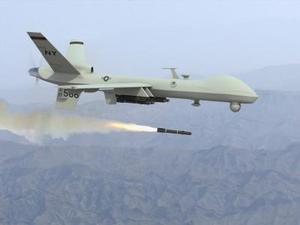Obama permits CIA to broaden UAV war target list in Pakistan
President Obama gave the CIA secret permission to attack a wider range of targets, including suspected militants whose names are not known, as part of a dramatic expansion of its campaign of UAV strikes in Pakistan’s border region; of more than 500 people who U.S. officials say have been killed since the pace of strikes intensified, the vast majority have been individuals whose names were unknown, or about whom the agency had only fragmentary information. In some cases, the CIA discovered only after an attack that the casualties included a suspected terrorist whom it had been seeking

Predator attacking // Source: for.org.uk
The CIA received secret permission to attack a wider range of targets, including suspected militants whose names are not known, as part of a dramatic expansion of its campaign of UAV strikes in Pakistan’s border region, according to current and former counter-terrorism officials.
The expanded authority, approved two years ago by the Bush administration and continued by President Obama, permits the agency to rely on what officials describe as “pattern of life” analysis, using evidence collected by surveillance cameras on the unmanned aircraft and from other sources about individuals and locations.
Los Angeles Times’s David S. Cloud quotes the officials to say that the information then is used to target suspected militants, even when their full identities are not known. Previously, the CIA was restricted in most cases to killing only individuals whose names were on an approved list.
The new rules have transformed the program from a narrow effort aimed at killing top al Qaeda and Taliban leaders into a large-scale campaign of air strikes in which few militants are off-limits, as long as they are deemed to pose a threat to the United States, the officials said.
Instead of just a few dozen attacks per year, CIA-operated unmanned aircraft now carry out multiple missile strikes each week against safe houses, training camps, and other hiding places used by militants in the tribal belt bordering Afghanistan.
As a matter of policy, CIA officials refuse to comment on the covert drone program. Those who are willing to discuss it on condition of anonymity refuse to describe in detail the standards of evidence they use for drone strikes, saying only that strict procedures are in place to ensure that militants are being targeted. Cloud writes that officials did say their surveillance yields so much detail that they can watch for the routine arrival of particular vehicles or the characteristics of individual people.
“The enemy has lost not just operational leaders and facilitators — people whose names we know — but formations of fighters and other terrorists,” said a senior U.S. counter-terrorism official, speaking on condition of anonymity. “We might not always have their names, but … these are people whose actions over time have made it obvious that they are a threat.”
In some cases, drones conduct surveillance for days to establish the evidence that justifies firing a missile, the officials said. Even then, a strike can be delayed or canceled if the chance of civilian casualties is
